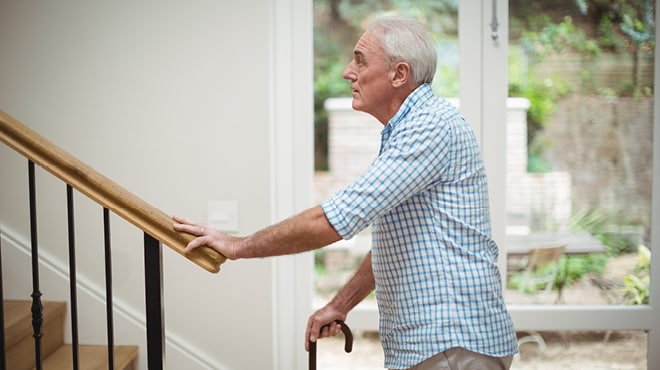A sudden slip on the stairs. A misstep in the bathroom. For many people, these moments are nothing more than minor inconveniences. But as we age, the consequences of falls can become far more serious—and in some cases, life-altering. Falls are a common issue among older adults, and understanding the risks and prevention strategies can be the key to preserving mobility, independence, and overall quality of life.
Why Falls Matter
Falls are one of the leading causes of injury in older adults, and their impact can be devastating. According to the Centers for Disease Control and Prevention, more than three million emergency room visits each year are the result of falls in patients over the age of 65. Nearly 300,000 of those cases involve hip fractures—a type of injury that can lead to long-term disability or even death.
It’s a harsh reality: as we get older, our bones become more fragile, our balance less reliable, and our ability to recover from injuries weaker. But while aging may increase the risk, falling is not an inevitable part of growing older. Many falls are preventable, especially when risk factors—both personal and environmental—are addressed proactively.
The Hidden Danger of Fragility Fractures
One of the most significant concerns following a fall is the risk of a fragility fracture. These are fractures that occur from a fall from standing height or less and are often linked to osteoporosis—a condition that causes bones to become brittle and weak. An estimated 10 million Americans are living with osteoporosis, and nearly half of those over 50 are at risk of developing it, particularly in areas like the hip, spine, and wrist.
Unfortunately, many people who suffer a fragility fracture don’t realize they’re at increased risk of another. The likelihood of a second fracture jumps fivefold after the first, yet only 20% of fracture patients receive proper screening or follow-up care. Without intervention, this cycle can continue, leading to greater injury and dependence.
How Falls Affect Daily Life
The impact of a fall often extends far beyond the initial injury. For many older adults, a serious fall can signal the beginning of a dramatic lifestyle shift. Recovery may require temporary stays at rehabilitation facilities, permanent relocation to assisted living environments, or an increased reliance on family members for daily tasks. Even younger adults, depending on the severity of the injury, may face similar disruptions as they heal.
Why Do Falls Happen?
Understanding what causes falls is the first step to preventing them. Fall risks can be broken down into two categories: personal (patient-specific) and environmental.
Personal Risk Factors Include:
- Bone Health: Conditions like osteopenia and osteoporosis increase fracture risk. A diet rich in calcium and vitamin D, as well as bone density screenings, can support stronger bones.
- Gait and Balance: Impaired walking due to neurological conditions, weak muscles, or inner ear issues increases fall risk. Physical therapy and the use of assistive devices such as canes or walkers can help.
- General Health: Low blood pressure, heart issues, or chronic illness can all lead to sudden dizziness or imbalance.
- Medications: Certain drugs may cause drowsiness or affect coordination. It’s important to regularly review medications with a healthcare provider.
- Cognitive Decline: Dementia can cause confusion or forgetfulness, which may lead to unsafe movements or poor decision-making.
- Sensory Impairments: Poor vision or hearing can affect spatial awareness. Annual check-ups help keep these senses sharp.
- Lifestyle Choices: Smoking weakens bones, and alcohol impairs judgment and coordination, both increasing the chance of falling.
Environmental Hazards to Watch For
Sometimes, the risk is all around us—literally. Everyday items and settings in the home can create dangerous situations if not addressed. Common hazards include:
- Poor Lighting: Dim hallways and staircases can hide obstacles or steps. Night lights and motion-sensor lighting can help.
- Slippery Floors: Water spills, polished surfaces, and waxed floors should be handled with care. Use nonslip treatments when possible.
- Loose Carpets and Rugs: Secure area rugs and remove or repair curled edges that can trip feet.
- Unsafe Stairs: Install sturdy railings on both sides and use non-slip tread strips. Avoid patterned carpeting that can obscure step edges.
- Cluttered Rooms: Keep floors clear of wires, furniture, and other obstacles that could become tripping hazards.
- Bathrooms: These are fall hot zones. Use grab bars, non-slip mats, shower chairs, and consider replacing glass enclosures with safer materials.
- Furniture and Cabinets: Choose chairs that are easy to rise from and store everyday items in easily reachable places. Never use unstable furniture to reach high places.
- Footwear: Opt for shoes with non-skid soles that fit well. Loose slippers and untied shoelaces are common culprits for trips and falls.
- Weather Conditions: Ice and snow add seasonal risks. Use salt to de-ice pathways, and wear appropriate footwear in winter.
- Pets: As lovable as they are, pets can be unpredictable. Be cautious around pets underfoot or long leashes that can tangle.
Prevention Is Powerful
Fall prevention is not just about avoiding injury—it’s about preserving independence. Simple adjustments in lifestyle and home setup, combined with regular health checkups and awareness of bone health, can drastically reduce the likelihood of a fall.
It’s important to remember that fall prevention isn’t just the responsibility of older adults. Caregivers, family members, and healthcare professionals all play a role in creating safe environments and encouraging healthy habits. If you or a loved one has experienced a fall or is at risk, don’t wait for another accident to take action. Talk to an orthopedic professional about how to stay safe and strong.
Falls may be common, but with the right knowledge and support, they don’t have to be life-changing. Stay informed, stay cautious—and most of all, stay upright.



